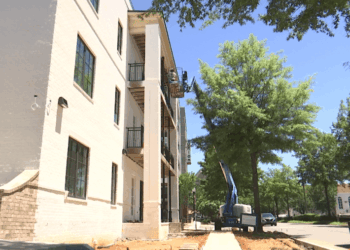My heart racing, I lay hidden with friends in the back of a wood-paneled station wagon as another teenager in our group steered us through the dimly lit ticket window, purchasing a single ticket. Once clear, and after selecting a parking spot, we shook out a blanket and sat back to relish the warm summer night, our unchaperoned independence and the glow of the larger-than-life outdoor movie screen.
This was in the 1980s, and my memories, of course, are colored by nostalgia. But has anything really changed at drive-ins across America?
Now decades later, I recently visited three drive-in theaters within a few hours of Bozeman, Mont., my hometown. Turning a deaf ear to political broadcasts and concerns about my teenage son’s extreme-sports endeavors, I welcomed the opportunity to attend screenings at the American Dream Drive-In in Powell, Wyo.; the Motor Vu Drive-In in Idaho Falls, Idaho; and the Silver Bow Drive-In in Butte, Mont.
It doesn’t take long to see that no two drive-ins are alike. The American Dream features original 1950s speakers, a vintage auto night and cheese fries. The Motor Vu touts an enormous movie screen (approximately 6,400 square feet), an expansive parking lot (470 spaces) and a packed community night with a bouncy house for kids. The Silver Bow has beautiful mountain views, twin screens and a longstanding place in the community (it opened in 1977).
It also didn’t take long for me to realize that the enduring power of drive-in movies is that they are at once transportive — a brief cinematic excursion to somewhere new — and accessible. You don’t need a flight reservation or itinerary. You don’t even have to drive in; you can often pedal or walk through the entrance gate.
Depending on how, when and where you attend, you could be part of a lively panorama colored by rows of both big ranch trucks and electric cars, along with lawn chairs, blankets, pajama-clad kids, Frisbees, hacky sacks, cornhole boards, footballs, baseballs, hammocks, dogs, hot dogs and fresh popcorn — and maybe even a sunset eclipsed by the screen.
You could also be a part of a quiet starlit night with shorter concession lines and less competition for a good parking spot.
One commonality, it seems: Every drive-in claims to have the best popcorn. And all three of the theaters I visited are family owned and operated. Each attracts a broad community of attendees, including beet and hay farmers, dairy farmers, welders, teachers, emergency medical workers, face painters, horse trainers, plumbers, landscapers, mechanics, stay-at-home moms, cosmetologists, aestheticians, engineers, nurses, hometown doctors and small-town lawyers.
There’s a multigenerational aspect to the moviegoers, too. Kathleen Heny, who goes by Pokey and has owned American Dream for 20 years, says she is now starting to see the kids and grandkids of former attendees at shows.
Sara Kindred, 30, a native of Powell, is one of them. She has been visiting the drive-in since she was 5 and now comes with her dog in tow. As it goes in small towns, Ms. Kindred knows Pokey’s family: Pokey’s mom used to work for Ms. Kindred’s grandfather at a family-owned trucking company.
At Silver Bow, I met Darrion McCracken and his partner, Vinny Juarez, who was wearing a geometrically patterned orange sweater reminiscent of the hallway carpeting in “The Shining.” The couple has been coming to the Silver Bow for 14 years. “We live out here during the summer,” Mr. McCracken said.
The couple’s loyalty to the Silver Bow has inspired them to help preserve it. Because the drive-in was recently threatened by nearby development, both have attended public meetings in hopes of protecting the theater and the surrounding land.
Modern drive-ins face a number of other obstacles, too, including the competition of streaming services, the high cost of land, the expense of new industry technologies required for showing a movie, and the cost of general upkeep around the property.
In some ways, it’s amazing these theaters still exist.
Richard Hollingshead opened the first drive-in theater in New Jersey in 1933. By some accounts, he was inspired by an effort to accommodate his mother, who was uncomfortable in traditional theater seats. The invention — he patented the idea — gained popularity with the introduction of in-car speakers, and by the 1950s and ’60s there were more than 4,000 drive-ins throughout America.
Today that number has dwindled to around 285 theaters, according to the United Drive-In Theatre Owners Association. (John Vincent, the president of the association, is also part owner of the Wellfleet Drive-In and Cinemas in Cape Cod.)
Jeff Ernster, an expert on all things outdoor theater, has made a name for himself in drive-in circles by traveling to about 30 theaters a year from his home base in Laramie, Wyo. Mr. Ernster says he sees about 150 shows a year. Often he goes to the same movie at the same theater multiple times, since the drive-in, he said, is as much about the experience as it is about the movie.
At showtime at the Silver Bow, I watched as the light softened and the mountains grew bright with alpine glow. And, as I appreciated the moment of calm, I thought about something Mr. Ernster had told me: “You don’t have to agree on everything to be able to hang out and enjoy the show.”
Follow New York Times Travel on Instagram and sign up for our Travel Dispatch newsletter to get expert tips on traveling smarter and inspiration for your next vacation. Dreaming up a future getaway or just armchair traveling? Check out our 52 Places to Go in 2025.
The post The Enduring Appeal of the American Drive-In appeared first on New York Times.




